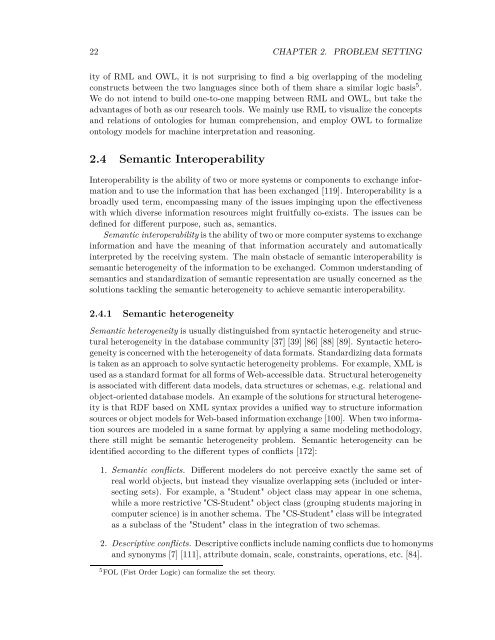Semantic Annotation for Process Models: - Department of Computer ...
Semantic Annotation for Process Models: - Department of Computer ...
Semantic Annotation for Process Models: - Department of Computer ...
You also want an ePaper? Increase the reach of your titles
YUMPU automatically turns print PDFs into web optimized ePapers that Google loves.
22 CHAPTER 2. PROBLEM SETTING<br />
ity <strong>of</strong> RML and OWL, it is not surprising to find a big overlapping <strong>of</strong> the modeling<br />
constructs between the two languages since both <strong>of</strong> them share a similar logic basis 5 .<br />
We do not intend to build one-to-one mapping between RML and OWL, but take the<br />
advantages <strong>of</strong> both as our research tools. We mainly use RML to visualize the concepts<br />
and relations <strong>of</strong> ontologies <strong>for</strong> human comprehension, and employ OWL to <strong>for</strong>malize<br />
ontology models <strong>for</strong> machine interpretation and reasoning.<br />
2.4 <strong>Semantic</strong> Interoperability<br />
Interoperability is the ability <strong>of</strong> two or more systems or components to exchange in<strong>for</strong>mation<br />
and to use the in<strong>for</strong>mation that has been exchanged [119]. Interoperability is a<br />
broadly used term, encompassing many <strong>of</strong> the issues impinging upon the effectiveness<br />
with which diverse in<strong>for</strong>mation resources might fruitfully co-exists. The issues can be<br />
defined <strong>for</strong> different purpose, such as, semantics.<br />
<strong>Semantic</strong> interoperability is the ability <strong>of</strong> two or more computer systems to exchange<br />
in<strong>for</strong>mation and have the meaning <strong>of</strong> that in<strong>for</strong>mation accurately and automatically<br />
interpreted by the receiving system. The main obstacle <strong>of</strong> semantic interoperability is<br />
semantic heterogeneity <strong>of</strong> the in<strong>for</strong>mation to be exchanged. Common understanding <strong>of</strong><br />
semantics and standardization <strong>of</strong> semantic representation are usually concerned as the<br />
solutions tackling the semantic heterogeneity to achieve semantic interoperability.<br />
2.4.1 <strong>Semantic</strong> heterogeneity<br />
<strong>Semantic</strong> heterogeneity is usually distinguished from syntactic heterogeneity and structural<br />
heterogeneity in the database community [37] [39] [86] [88] [89]. Syntactic heterogeneity<br />
is concerned with the heterogeneity <strong>of</strong> data <strong>for</strong>mats. Standardizing data <strong>for</strong>mats<br />
is taken as an approach to solve syntactic heterogeneity problems. For example, XML is<br />
used as a standard <strong>for</strong>mat <strong>for</strong> all <strong>for</strong>ms <strong>of</strong> Web-accessible data. Structural heterogeneity<br />
is associated with different data models, data structures or schemas, e.g. relational and<br />
object-oriented database models. An example <strong>of</strong> the solutions <strong>for</strong> structural heterogeneity<br />
is that RDF based on XML syntax provides a unified way to structure in<strong>for</strong>mation<br />
sources or object models <strong>for</strong> Web-based in<strong>for</strong>mation exchange [100]. When two in<strong>for</strong>mation<br />
sources are modeled in a same <strong>for</strong>mat by applying a same modeling methodology,<br />
there still might be semantic heterogeneity problem. <strong>Semantic</strong> heterogeneity can be<br />
identified according to the different types <strong>of</strong> conflicts [172]:<br />
1. <strong>Semantic</strong> conflicts. Different modelers do not perceive exactly the same set <strong>of</strong><br />
real world objects, but instead they visualize overlapping sets (included or intersecting<br />
sets). For example, a "Student" object class may appear in one schema,<br />
while a more restrictive "CS-Student" object class (grouping students majoring in<br />
computer science) is in another schema. The "CS-Student" class will be integrated<br />
as a subclass <strong>of</strong> the "Student" class in the integration <strong>of</strong> two schemas.<br />
2. Descriptive conflicts. Descriptive conflicts include naming conflicts due to homonyms<br />
and synonyms [7] [111], attribute domain, scale, constraints, operations, etc. [84].<br />
5 FOL (Fist Order Logic) can <strong>for</strong>malize the set theory.
















